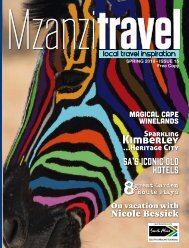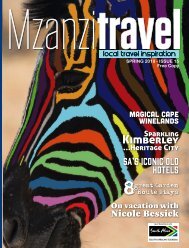Create successful ePaper yourself
Turn your PDF publications into a flip-book with our unique Google optimized e-Paper software.
Discover<br />
Naeblys / Shutterstock<br />
Francesco Dazzi / Shutterstock<br />
Pilgrims’ Rest…reliving the gold rush<br />
Walk down the main street. Close your eyes and hear the rowdy celebrations in<br />
the saloons of panners and diggers who found gold today. There’s loud music,<br />
even louder voices, gambling, drinking and good-time dancing girls kicking their<br />
legs high in the air. A digger walks into the Church Bar at the Royal Hotel, slaps<br />
a gold nugget on the counter and orders drinks for everybody. He is loudly<br />
cheered and a gun shot or two are even fired off in drunken appreciation.<br />
Some of the less rowdy town folk are buying supplies in the general dealerships,<br />
bakery and other tin-roofed, corrugated iron shops lining the street. Welcome<br />
to Pilgrim’s Rest, the miner’s town still frozen in the time of South Africa’s<br />
second gold rush in 1873.<br />
In 1873 gold was discovered on the farm Geelhoutboom in present-day<br />
Mpumalanga. The president of the Transvaal (or old South African Republic)<br />
gave it the official name of the New Caledonian Gold Fields, but the miners and<br />
farmers of the area preferred calling it Mac Mac because of the many Scottish<br />
diggers at the camp that quickly sprang up. Within that same year, gold was also<br />
discovered nearby at what was to become the town of Pilgrim’s Rest. The third<br />
gold rush took place at Millwood in the forest outside Knysna in 1876, followed<br />
by the Barberton gold rush of 1881. Only in 1886 did the great gold rush at<br />
Langlaagte take place where the metropolis of Johannesburg stands today.<br />
The mining camps and early towns of Mac Mac and Millwood have disappeared,<br />
those of Langlaagte grew into one of Africa’s biggest and wealthiest cities. But<br />
Pilgrim’s Rest, clinging to the side of a steep, forested hill near the Blyde River<br />
Canyon, remained. It has hardly changed since the heady gold rush days, with<br />
most of its old buildings restored to their original. Unfortunately the town has<br />
not been well maintained the last few years and tourist numbers here have<br />
fallen. But it’s still very much worth a visit, and perhaps the partial dilapidation<br />
gives it even more of an atmosphere going back in time.<br />
Steve Heap / Shutterstock<br />
After crossing the Joubert Bridge built in 1896 into town, you can visit the<br />
many restored buildings still housing shops, pubs, restaurants, curios shops, a<br />
hotel and museums, among others. At Alanglade House, an elegant Edwardian<br />
house built in 1915 and furnished with period pieces, you can see how the mine<br />
manager once lived. There are also a print shop, general dealers, hairdresser,<br />
bakery and more.<br />
In the Royal Hotel you can still sleep in a Victorian-era room, or have a drink<br />
at the bar that first saw service as a Roman Catholic chapel in old Lourenco<br />
Marques (now Maputo) in neighbouring Mozambique. It was at this very same<br />
bar where Tommy Dennyson, the village laundryman, used to drink, before he<br />
rode his horse up into the hills above the village to carry out South Africa’s last<br />
stagecoach robbery. After the robbery he was arrested in the bar, busy paying<br />
off his debts with his robbery haul, and Pretoria Central Prison became his next<br />
home.<br />
MZANZI TRAVEL| www.<strong>mzanzi</strong>travel.co.za|ISSUE 6 | 31<br />
Aqua Images / Shutterstock

















